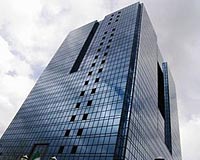 |
Riyadh, Saudi Arabia (UPI) Aug 30, 2010 A proposed $60 billion arms deal with Saudi Arabia, one of the largest-ever U.S. weapons sales, marks the consolidation of America as the kingdom's main arms supplier after years of strain following 9/11. The deal, which includes Boeing F-15SA Strike Eagle fighters, also underlines Riyadh's determination to confront the threat it perceives from Iran, Saudi Arabia's rival for regional supremacy and leadership of the Muslim world. The Pentagon advised the U.S. Congress of the proposed multi-layered deal, which is expected to win approval in September. That's because the administration of President Barack Obama, committed to ensuring that its ally Israel retains its long-held qualitative military edge in the region, has assured Israeli leaders the Saudis won't receive cutting-edge technology, particularly long-range missiles. Significantly, the American Israel Public Affairs Committee, the powerful pro-Israel lobby in Washington, has raised no public objections to the proposed deal with Riyadh. If that remains the case, pro-Israeli lawmakers will likely wave the deal through Congress. There are other considerations. Saudi Arabia and Israel have found themselves linked by their deep fears of a nuclear-armed Iran. This hardly makes allies out of these longtime foes. But, in a changing world, the Israelis appreciate that the more able Saudi Arabia and the Persian Gulf Arab states are stand up to Iran, and support U.S. forces in the region, the better off they will all be. Word of the massive arms deal was first reported Aug. 13 in Washington. "Contacts for the deal were conducted secretly due to Saudi sensitivity," said Israeli analyst Yiftah Shapir of the Institute for National Security Studies. "At the same time, however, there were hints that the deal would not include equipment items that could arouse serious opposition on the part of Israel, such as long-range precision-guided air-to-surface missiles." Whether arming the Saudis with advanced weaponry to stand up to Iran will help U.S. leaders convince Israel not mount threatened pre-emptive strikes against the Islamic Republic's nuclear facilities isn't clear. It will take several years for the Saudis to receive and absorb the new weapons systems, and that may be longer than the Israelis will accept. But, as Shapir notes, while "the United Arab Emirates and Kuwait preferred investing most of their money in defensive equipment (mainly air-defense and anti-ballistic missile defense systems), the Saudi deal is for aerial attack equipment (fighter jets and assault helicopters)." The planned U.S. sales to Riyadh are expected to fall into four phases over the next 10 years. The first involves 84 F-15SA -- the "SA" stands for "Saudi Advanced" -- strike aircraft configured to Saudi specifications to replace its aging F-15C/D air-defense variants acquired in 1978-92, plus upgrades for 70 F-15S strike jets already in service. The second embraces an expected 72 UH-60 Black Hawk helicopters, the U.S. Army's main anti-tank helicopter manufactured by United Technologies Corp. that will augment the 22 the Saudi air force already operates. This package also includes up to 60 Boeing AH-64D Apache Longbow attack helicopters, plus possible upgrades for the 12 AH-65As Congress cleared for Riyadh in 2008. The helicopter sales would total some $30 billion. The third phase comprises advanced, helicopter-carrying offshore patrol vessels worth up to $5 billion. The fourth segment consists of upgrades for the 96 Raytheon-built Patriot Advanced capability 2 missiles already in Saudi hands. Jane's Defense Weekly reported that life-cycle maintenance and upgrades could eventually double the $60 billion value of the deal. Aviation Week reported that a major sticking point in the deal was Riyadh's demand the new F-15SAs carry the long-range Raytheon AESA radars, such as the APG-63(v)3 on upgraded U.S. Air Force and Singapore air force models. The magazine said these could nearly triple the sensor's range for detecting small targets, such as fighter-sized aircraft, from the current 56 miles to about 150 miles. "More importantly, AESA radars can find and target small moving ground targets at long ranges so they can be struck with standoff weapons beyond the range of anti-aircraft weapons," Aviation Week reported. "The combination of a large AESA radar and a powerful new air-to-air weapons would help match the Middle East's growing short-range missile proliferation problem and help contain a nuclear weapons threat from Iran that worries planners in the region."
Share This Article With Planet Earth
Related Links Learn about nuclear weapons doctrine and defense at SpaceWar.com Learn about missile defense at SpaceWar.com All about missiles at SpaceWar.com Learn about the Superpowers of the 21st Century at SpaceWar.com
 Iran bank assets withdrawn from Europe: central bank chief
Iran bank assets withdrawn from Europe: central bank chiefTehran (AFP) Aug 27, 2010 Iran's central bank chief said on Friday that Tehran has withdrawn the assets held by its banks in Europe to escape the latest round of international economic sanctions over its nuclear drive. "The Central bank ... has transferred the (Iranian) banks' assets from Europe. Currently there is no problem in regards to blocking of assets of the Iranian banks by the European Union," Mahmoud Bahman ... read more |
|
| The content herein, unless otherwise known to be public domain, are Copyright 1995-2010 - SpaceDaily. AFP and UPI Wire Stories are copyright Agence France-Presse and United Press International. ESA Portal Reports are copyright European Space Agency. All NASA sourced material is public domain. Additional copyrights may apply in whole or part to other bona fide parties. Advertising does not imply endorsement,agreement or approval of any opinions, statements or information provided by SpaceDaily on any Web page published or hosted by SpaceDaily. Privacy Statement |